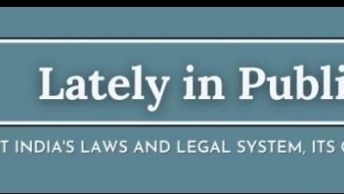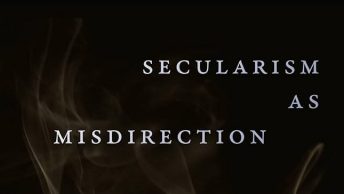In a week where Indians have been discussing institutional reform, Mariana Mota Prado of the University of Toronto, School of Law, published her paper suggesting Institutional bypasses as a way of development reform.
Prof Prado argues,
“Beginning in the 1990s, an institutional perspective on development has become increasingly prominent in development thinking, captured in the mantra, “Institutions Matter,” or “Governance Matters.” Based on the assumption that “institutions matter”, there has been a massive surge in development assistance for institutional reform projects in developing and transition economies involving investments of many billions of dollars. However, these reforms have had mixed to disappointing results thus far. Against this backdrop, this paper identifies successful institutional reforms, and claims that they have one common feature: instead of trying to fix dysfunctional institutions, as most failed reforms do, they simply bypass them. For this reason, they will be called “institutional bypasses”. Like a “coronary bypass” surgery, an institutional bypass creates new pathways around clogged or blocked institutions. Institutional bypass uses the same strategy: it does not try to modify, change or reform existing institutions. Instead, it tries to create a new pathway in which efficiency and functionality will be the norm. Understanding what is a bypass and how it works can provide answers to an important question in the law and development literature: how to reform dysfunctional institutions. This paper argues that under certain circumstances an “institutional bypass” presents a promising alternative for institutional reforms in developing countries, but at the same time it should not be regarded as a panacea for development problems”
It would be promising to think of this in the Indian context, if only to get a sense of the stakes involved in institutional reform.
Also relevant is a debate between Kaushik Basu and P. Sainath over Basu’s proposal to legalize certain forms of bribe giving as “acceptable costs”. Basu’s argues that this might lead to a decline in bribe taking, as someone who pays a bribe to get her work done, might on completion be interested in cooperating in getting the bribe taker caught. Sainath, in a cutting riposte argues that this ‘obscene idea’ would serve the middle classes but leave the poor even more disempowered than before
Update
Jean Dreze responds to Basu as well. He argues, “It may be argued that paying a harassment bribe is not morally reprehensible in the first place, because the bribe-giver is a victim and the bribe is an act of self-defence. I am not persuaded. When you pay a harassment bribe, you abdicate your duty to use other means to resist the harassment, not only for yourself but also on behalf of others who might face the same situation. You also secure an advantage for yourself, vis-à-vis others who may not be able or willing to bribe. This does not sound particularly ethical.”
More strikingly he takes issue with a certain brand of economics, ” Kaushik Basu’s paper is symptomatic of a common disease in the economics profession: the tendency to make sweeping policy recommendations based on analytical models that have a very limited domain of validity. “
Interestingly, both Dreze and Basu hold official positions as policy makers to the UPA government







There is one valid point in Sainath's verbiage. To see this, imagine that with the current legal regime, there are 100 bribes. (Any positive number will do, actually, for the thought experiment.) Now suppose the legal regime is changed to be in tune Basu's proposal. What should we expect to happen?
Well, to start with, some of the 100 bribe takers (for every bribe, there is a giver and a taker) will no longer want to take a bribe because it is now more risky. (The additional risk is that the bribe giver might now complain as it is costless for her to do so.) However, even with this additional risk, there may still be some who might want to take a bribe and these will want demand more as a bribe to compensate for the increase in risk.
So the impact of Basu's proposal is two-fold: (i) some bribe takers will no longer want to take a bribe, and (ii) those who still want to take a bribe will demand more.
Note that while the first is beneficial (lesser number of bribes), the second actually harms the bribe givers because they have to pay more. A priori it is not clear which effect is the more significant.
At one extreme, suppose the total number of bribes falls from 100 to 25, while the quantum of bribe increases from Rs. 1000 (say) to Rs. 1100. We would then be justified in saying that society as a whole is better off. Yes, the 25 bribe givers now have to pay Rs. 100 more but one can argue that this effect is overshadowed by the decrease in the total number of bribes.
At the other extreme, imagine that the number of bribes decreases from 100 to 90 but the bribe amount goes up from Rs. 1000 to Rs. 2000. In this case, we could argue that bribe givers (and society as a whole) are actually worse off because while there has been a small decrease in the number of bribes, this is overshadowed by the fact that the bribe amount has increased substantially.
Which of the two extreme scenarios is closer to what might actually happen? It is not clear to me but Sainath clearly seems to think that the second is closer to the truth. That may be true but he needs to argue this out instead of talking nonsense and accusing Professor Basu of supporting child labour. For the record, Professor Basu talks about the wisdom of a policy of abolishing child labour: this is not the same as supporting child labour. One can question the wisdom of a policy banning child labour without supporting child labour.
The more I read Sainath the less I like him. I am sure I am out of tune with most who write or comment on this blog. Personally, I think Basu's proposal is worth debating instead of being dismissed out of hand.
I wonder whether RTI relatedeffortscan be considered as institutional byasses. There are some reports of success by Peisakhin and Pinto:
http://www.accountabilityindia.in/sites/default/files/document-library/regulationandgovernance_peisakhin.pdf
Suresh, good point. I think you're right – more specific quantitative work is required to make Basu's case watertight. But here's an initial analytical suggestion for thinking he might be onto something on that specific point, too:
Firstly, unlike you, I assume differentiation not between bribe-takers, but bribe-givers. Obviously, one hopes the mechanism works so that the bribe-takers stop demanding bribes. But imagine a bribe-taker keeps demanding. He has increased his bribe to Rs. 1100. There is nothing to prevent me reporting him – just as I would have reported the guy demanding Rs. 1000. The bribe-taker can still demand bribes only if the the threat of reporting (and enforcement) is not credible, say because the bribe-givers are all very poor and have no recourse to legal enforcement, i.e. differentiation takes place between bribe-givers' ability to report. The bribe-giver has some screening mechanism so he knows when gain from bribe > probable loss from being reported.
Imagine that the poor now have to pay X + Y, where Y is the risk premium. In order for the Basu mechanism to be overall positive, the contribution of Y to the overall calculus has to be lower than that of the fall in the number of bribes that are stopped by the Basu mechanism. But as Y increases and threatens to make the Basu mechanism unsuccessful, the poor have more of an incentive to report the bribe. It is now more likely that gain from reporting (which is = bribe paid) – legal recourse costs > 0. An increase in the risk premium will have a countervailing effect on the number of bribes that are not reported. A limiting factor.
A second point of note is that the risk premium will increase more when more rich people start reporting. There we have a key argument – if enough rich people report, the risk premium rises to a level that means the poor start reporting. Bribes go down altogether.
Anyway, I've noted some of these considerations in an initial post here: (http://kanishkanarayan.wordpress.com/2011/04/22/sainaths-folly/). Sorry to cross-reference to my blog in all my comments!
Agree entirely on disappointment with Sainath.
Suresh,
Interesting comment. I generally agree but a couple of things. A complainant has to go through a certain amount of trouble to see any bribe taker nailed and he/she is only likely to put up with that if the harassment crosses a certain threshold. Inter alia, a higher bribe amount would thus be beneficial for law enforcement because it diminishes the congruence of interest between the giver and taker even before the transaction is completed and the likelihood of the giver coming forward is enhanced. Secondly, the primary goal here is to find bribe takers and put them away and a decrease in the number of bribes paid will only be an indirect fallout of that. A correlation may be expected but would not likely be linear because not every official will necessarily take the same number of bribes. Aside from the standpoint of cost efficiency, we would also have to consider the cost/benefit question of how many folks you can put away with – as opposed to without – the cooperation of the giver.
All of this will work if the giver is determined to see the transaction through which may not be the case (as Sainath rightly suggests) – when the threshold is crossed, he/she may simply give up and walk away with the matter ending there in which case, the bribe may not be paid but the corrupt official is not brought to book either. But I do not see how that problem is alleviated in any way by threatening to prosecute the giver.
Sainath's writing was fun to read but aside from a point or two, it hardly counts as a constructive critique. He is good with sarcasm and parody which can make for strong rhetoric but seldom offers any credible policy alternatives based on economic imperatives. It might appeal to sections of the academic left but is otherwise lacking in meaningful content to be taken seriously.
Sainath's critique notwithstanding, Basu's proposal works if one key assumption holds good i.e. bribe givers do not report bribes for fear of prosecution. At least in the IP field where i work, this may not hold true.. I've been part of a group attempting to rid IP offices of corruption through a transparency campaign for the last 5 or so years…and we've seen plenty of harassment bribe cases…money demanded for the patent and trademark certificates that applicants are otherwise entitled to…the lack of complaints (at least in this sphere) does not owe itself to a fear of prosecution…but rather to the fact that often times, both attorneys and clients have a continuing relationship with the office that they do not wish to jeopardise….i'm not sure how this might hold out in other areas, but am skeptical of the view that we're not seeing enough complaints owing to bribe givers' fear of prosecution..